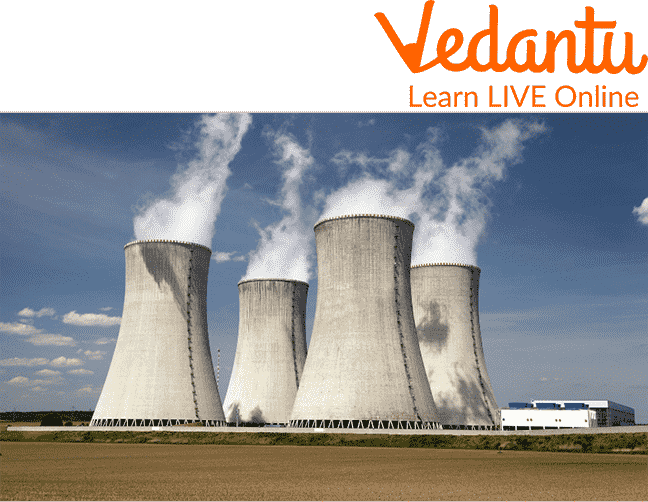




Overview of Nuclear Energy
Nuclear or atomic energy is the force that preserves the integrity of an atom's nucleus. The fundamental building blocks of matter are atoms. The core of an atom is its nucleus. Nuclear energy converts into different forms of energy as it is released. These energy types are referred to as radiation. Radiation can take the form of heat or light. Nuclear energy is a very interesting and fascinating topic for you to dig into and learn about, so let us find out more about nuclear energy's meaning.
What is Nuclear Energy?
A highly powerful form of energy is nuclear energy. Many homes all around the world use it to generate electricity, and it can even be used to make bombs!
Protons, neutrons, and electrons make up an atom, the smallest unit of matter. An atom's nucleus is located at the centre. Protons and neutrons make up the nucleus. Heat energy is produced whenever the nucleus is altered in some way. Nuclear energy is the name for thermal energy.

Nuclear Energy
Nuclear Energy Examples
Nuclear Medicine
A few of the leftovers produced during nuclear fission in units are crucial for certain medical fields. For example, hospitals utilise cobalt-60 to clean complex medical equipment, such as implants, tubes, and surgical tools, as well as other types of equipment. Additionally, it is applied in medical imaging and therapy for the treatment of cancer.

Nuclear Medicines
Food Treatments
In the food and agricultural industries, nuclear energy and science are used to increase safety and efficiency. To limit the need for insecticides, agricultural pests are killed using nuclear-related technology. This prevents the bugs from reproducing, gradually wiping them out.
Uses of Nuclear Energy
Exploration of Space
Radioactive power systems have allowed us to learn a lot about deep space (RPSs). In the harsh conditions of deep space, spacecraft are powered by these tiny nuclear power sources.

Exploring the Universe with Nuclear Energy
Police Investigation
Radioisotopes are often used by criminal investigators to gather tangible proof connecting a suspect to a particular crime. Substances like paint, glass, tape, explosives, lead, and poisons, can be used to find trace compounds.
Production of Electricity
Nuclear energy is also used to produce electricity with the help of nuclear power plants. The electricity produced by nuclear energy is clean and sustainable. Nuclear power plants can produce high capacity, clean, reliable and uninterrupted electricity for a longer period of time.
Fission and Nuclear Energy Interesting Facts
The top three nuclear energy-rich states in the US are South Carolina, Pennsylvania, and Illinois.
More nuclear energy is produced in the US than in any other country.
Three major nuclear power plant disasters—Chornobyl (Russia), Three Mile Island (United States), and Fukushima Daiichi—have happened in the history of nuclear energy (Japan).
The U.S.S. Nautilus, which sailed into the ocean in 1954, was the first submarine driven by nuclear energy.
The energy produced by one uranium pellet is equivalent to that of about 1,000 kg of coal.
Steam, not pollution, is what you notice flowing from a nuclear power plant.
Summary
In this article, we have learnt Nuclear Energy Definition for Kids with various nuclear energy diagrams. We know that no other sources of electricity can compare to nuclear power in terms of efficiency and stability. Nuclear power facilities are capable of providing large amounts of electricity continuously and without interruption for several months at a time. Approximately 10% of the electricity used to run homes, companies, schools, and hospitals today comes from nuclear energy. Nuclear power stations must be taken care of properly to avoid an explosion. Care must be taken to ensure that the radioactive waste produced does not come into connection with the environment outside. We hope you enjoyed reading this article, in case of any doubts feel free to ask in the comments.
FAQs on Nuclear Energy Definition for Kids
1. How are lives saved by nuclear energy?
It is necessary to contrast the lower risks of nuclear energy with the elevated risk of other energy sources, especially fossil fuels. Nuclear power has substituted some fossil generators, reportedly saving 2 million lives since 1971.
2. What materials constitute nuclear fuel?
A complicated mixture of uranium, plutonium, and trans plutonium metals make up used nuclear fuel. It is typical for fuel that has been burned at high temperatures in power reactors to be heterogeneous and to contain particles of platinum group metals, such as palladium.
3. How is nuclear waste treated?
For around five years, power is produced using nuclear fuel. After that, it is taken out and securely kept until a location for long-term disposal is open. Nuclear power facilities also produce low-level radioactive waste, which is routinely and safely disposed of at several locations across the nation.









